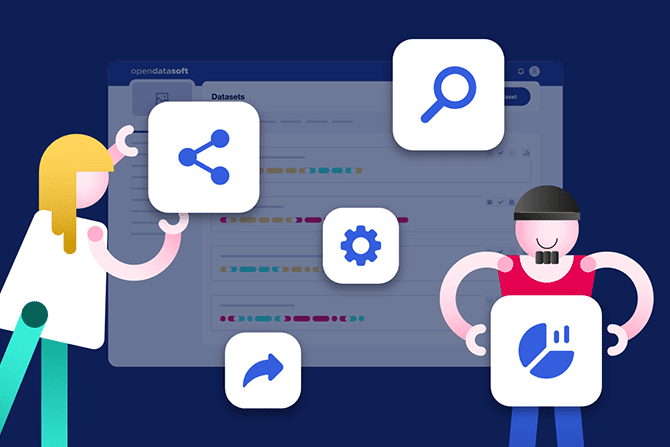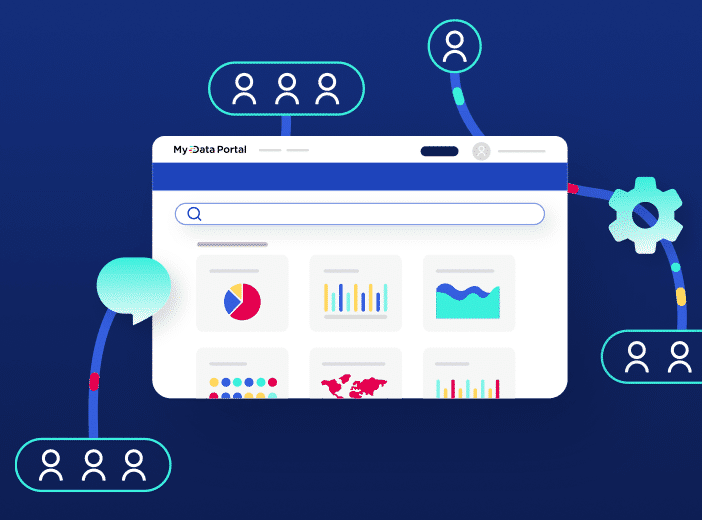How to create the best data experiences: key features that customers love when democratizing data
Data democratization requires a strong data experience platform that is flexible enough to meet a range of user needs. In this blog we bring together a selection of our customers’ favorite features that help them save time and deliver compelling data experiences.

The data experience layer is a key part of the data tech stack, enabling organizations to become data-driven and embrace data democratization.
We’ve already explored the key features you should look for in your data experience platform, and in this follow-up article we asked our Customer Success Managers (CSMs) about the specific elements that customers love when using the Opendatasoft platform.
Here’s a round-up of what they said, organized by the five stages of the data journey.
Connect all your data sources
Being able to quickly, and easily connect all potential data sources is the vital foundation of every data project. Our customers highlight multiple features that help them seamlessly connect internal and external data sources:
Easy internal and external connections
The Opendatasoft platform has over 80 standard connectors to common data sources, from data lakes, data warehouses, business intelligence tools and corporate applications (such as SharePoint and Google Drive). Data doesn’t just come from internal sources – in many cases customers want to harvest information from other, external catalogs. For example, a city might want to include data on its museums that is published by a state or national government agency. Again, these connections are easy to create and can be set to automatically update when new data is available.
Automated connection and publication
Customers have a wide range of data sources, some of which are static, while others contain information that changes regularly. Opendatasoft allows you to automate when and how data is updated. That means customers never have to worry about their information being out of date, saving valuable time. Data can be updated in one of two ways:
- Scheduled updates at a specific, fixed interval (such as daily or weekly). This is particularly useful for datasets that are themselves published or refreshed on a regular basis.
- Real-time updates through dedicated APIs. This refreshes the dataset as soon as an update is made, and is especially helpful when linking to sources such as IoT sensors.
To save further time, the Opendatasoft platform provides the ability to memorize these connections to FTP and HTTP servers and business applications such as SharePoint and Google Drive. These shortcuts can then be reused securely to create other datasets.
The ODS Data Hub
Opendatasoft itself is a major publisher of open data, with a dedicated team running its Data Hub, which contains both publicly available data and open data shared by customers. Adding value, the dedicated Data Hub team standardizes and updates all datasets, ensuring consistency and quality. This data can be accessed seamlessly through the Connection tab of the platform, making it as simple to use as any other data source. Showing the benefits, one customer has shared multiple datasets on the Data Hub, while also using information from the Hub to enrich its own data. It’s a win-win scenario for all.
Prepare and enrich your data
To get maximum value from raw data it is essential to prepare it, ensuring it is high quality and then to enrich it with additional datasets. The Opendatasoft platform helps achieve this in four key ways:
Processors to prepare and correct data
Opendatasoft provides more than 50 processors that enable users to correct or modify their datasets without having to write a single line of code. All of these processors allow customers to carry out operations that include:
- Add geographic location data, or apply geographic/area transformations. In France you can use geolocation from an address to get a geopoint and a map, automatically, saving further time.
- Correct the text and formatting (such as of dates)
- Reshape dataset content. Many datasets contain jargon or terms that aren’t understandable to a wider audience, such as citizens, and customers can replace these automatically during the preparation stage, helping the push for data democratization. Also, when importing data, customers can also skip irrelevant parts of a dataset – for example, a city or region can choose to just import parts of a national dataset that apply to its geographical area.
- Pseudonymize data to protect privacy, while ensuring it is still useful for analysis
As well as the range of processors available in the platform, customers appreciate these specific features:
- Automatic recognition of field types for faster data processing
- The ability to rename processors in the back office, making it clear what each one does, ensuring it is easy to find them again
- Temporary activation and deactivation of processes to avoid their permanent deletion
- Real-time preview of the results of processing operations applied to each dataset
Reference data packs
Through the Opendatasoft platform customers have access to structured reference data packs of geographical and business information. These can be easily reused to enrich their datasets, all governed by an open license.
Seamless joining of datasets
The join function within ODS enables multiple datasets to be quickly combined as part of the preparation and enrichment phase. For example, a user can add a public dataset from the ODS Data Hub to their own data, deepening the potential for reuse.
Publish your data catalog
Once data is prepared, ODS helps customers to streamline publishing their data catalog, particularly when it comes to simplifying search and access management.
Making it easy for users to find relevant data
The ODS platform allows organizations to create a data catalog with in-built filtering and search options, aiding navigation for users. At the preparation stage the addition of metadata can be automated and imported via an FTP server. This makes it easy for users to search and find relevant data, while reducing administration for the data team, as it saves them significant time compared to adding metadata manually or at an individual dataset level.
Ensuring secure, auditable access management
Administering a large number of datasets and choosing who is able to access them, and at what level can be complex. However, with Opendatasoft data governance is simplified through a combination of features.
Global policies allow organizations to set which data is shared with particular groups, helping with governance and security while saving time. The platform allows customers to give access at a global, dataset, and row level dependent on people’s role. Catalogs can be made private or public with a single click.
Visualize your data
Most people find it easiest to understand data when it is displayed visually, making the data visualization stage crucial to data democratization. Compelling data visualizations bring data to life and the Opendatasoft platform provides a full range of options to enable customers to:
- Choose the best type of visualization for their dataset (for example map, table or dashboard)
- Which metrics to display
- Edit the visualization to add further information, such as text
- Combine different visualizations on the same page to provide deeper insight
- Create several different types of visualization for each dataset, helping to give different perspectives and putting data in context.
ODS Studio
The Opendatasoft platform lets users design memorable data visualizations in minutes, particularly through the no-code ODS Studio. The Studio’s intuitive interface helps customers to organize their content blocks through drag and drop, configure visualizations with just a mouse and enter text directly onto the page with a WYSIWYG editor. Real-time previews exactly reflect the actions users take, and visualizations are 100% responsive to fit all screen sizes, from mobile to PC.
Showing the benefits of the ODS Studio, electricity company EDF was able to quickly create a dashboard to share its CSR indicators in a simplified form, without requiring technical skills.
Giving customers autonomy
Essentially customers are in control – they can easily customize how visualizations look to match their corporate design guidelines through adjustable color palettes, choice of typography, a selection of backgrounds and button style management. Thanks to the intuitive nature of the platform they can build visualizations without requiring assistance from Opendatasoft or their IT team. They have the autonomy they need to democratize data. The ODS platform can even bring in existing data visualizations from other vendors to make management simpler.
Share your data with internal and external ecosystems
Seamlessly sharing data with the right audiences is central to its effective reuse. The Opendatasoft platform therefore focuses on making it straightforward to share with the right people, in the right formats, to maximize the value of every customer’s data.
Workspaces to segment sharing
Opendatasoft enables organizations to create different workspaces (or sub-domains) within their data portal. This means different local authorities within a region could have their own portals and share data at a wider level. This is supported through a shared catalog across workspaces so users can see which datasets are available at both a local and regional level.
For example, public sector organizations may want to share some data internally, other datasets with partners and further information with the general public, such as through a webpage. This can be done quickly and easily through the platform.
Advanced sharing options through APIs
The Opendatasoft platform is built on flexible, agile APIs. Essentially whatever the format of the data you bring in, you can share it through any output format (such as a map or other data experience, JSON, Snowflake), all handled transparently for non-technical users. For each dataset an API is automatically generated, making sharing seamless. This also makes it simple to create apps based on the data.
Demonstrating this, a city near Paris is able to personalize open data to create a service that shows local schools and their catchment areas to parents based on their location.
API management is a clear strength mentioned by customers, particularly more technical users. It can be automated so that, for example if the source changes it will be done automatically, avoiding errors.
With APIs people can also configure the types of information they are interested in, so they are notified when there is new data within specific datasets.
Export results to all
As well as being able to easily share data through websites, apps, and social media, customers like the fact that it is very easy to export data in different types, including Excel, CSV, APIs, and as GIS data, such as GPX for smartphone mapping. Outputs are also compatible with national and international standards, allowing easy integration with country portals.
Easy to use all-in-one platform
All of these features, contained within a single, all-in-one platform, add up to two major benefits for ODS customers – they can save time and they have greater control and independence over their data experiences.
Saving time
Customers like the fact the platform is easy to use – even if you are not a data expert. In some organizations ODS is used by communications teams, rather than technical staff. As well as its intuitive interface, the platform helps save time in other ways. For example, if the education department of a city has to update details about a school (such as a new principal or telephone number) they can do it once in ODS and it will then cascade to everywhere the data is used (website, apps, intranet). This also ensures consistency.
Autonomy, but full support
Opendatasoft’s technology is backed by comprehensive support from our dedicated Customer Success Managers, who have worked with clients on more than 2000 data projects in over 25 countries. In-depth training, support, and advice from CSMs provides help, advice and best practice to get started and to tackle new projects, empowering customers to quickly move forward and achieve their data sharing objectives. This knowledge transfer, plus the intuitive nature of the platform means that customers soon have the independence to create their own data experiences, giving them complete control. This autonomy encourages greater use and therefore speeds up data democratization.




